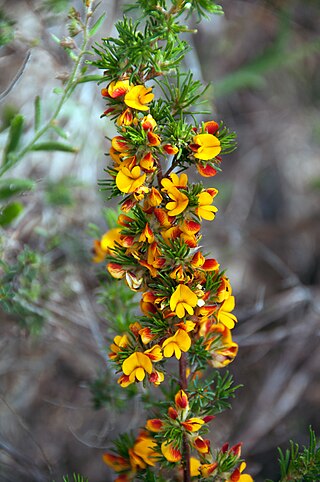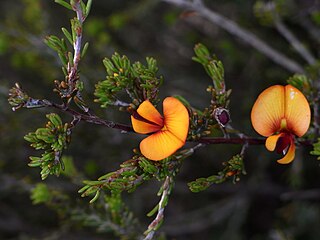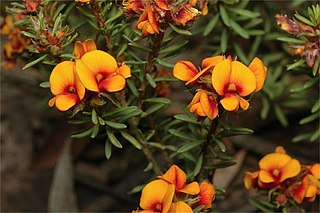
Pultenaea muelleri, commonly known as Mueller's bush-pea, is a species of flowering plant in the family Fabaceae and is endemic to Victoria, Australia. It is a dense shrub with hairy stems, elliptic to narrow egg-shaped leaves with the narrower end towards the base, and yellow and red flowers arranged singly or in pairs on the ends of short side shoots.

Pultenaea juniperina, commonly known as prickly bush-pea or prickly beauty is a species of flowering plant in the family Fabaceae and is endemic to south-eastern Australia. It is an erect, spiky shrub with hairy stems, linear to narrow elliptic leaves with stipules at the base, and yellow-orange and red flowers.

Pultenaea acerosa, commonly known as bristly bush-pea, is a species of flowering plant in the family Fabaceae and is endemic to south-eastern continental Australia. It is a rigid, much-branched shrub with glabrous, grooved, needle-shaped leaves and yellow flowers with red veins.

Pultenaea altissima, commonly known as tall bush-pea, is a species of flowering plant in the family Fabaceae and is endemic to south-eastern continental Australia. It is an erect shrub with spatula-shaped to egg-shaped leaves and yellow flowers in clusters at the ends of branches.

Pultenaea glabra, commonly known as smooth bush-pea, is a species of flowering plant in the family Fabaceae and is endemic to eastern New South Wales. It is an erect shrub with glabrous stems, linear to egg-shaped leaves with a concave upper surface, and yellow to red and orange flowers.

Pultenaea hispidula, commonly known as rusty bush-pea, is a species of flowering plant in the family Fabaceae and is endemic to south-eastern continental Australia. It is an erect, spreading shrub with many drooping branches, oblong to egg-shaped leaves with the narrower end towards the base, and yellow to pale orange and red flowers.

Pultenaea humilis, commonly known as dwarf bush-pea, is a species of flowering plant in the family Fabaceae and is endemic to south-eastern Australia. It is a spreading, often low-lying shrub with branches that are hairy when young, elliptic to lance-shaped leaves with the narrower end towards the base, and yellow to orange and red flowers.

Pultenaea involucrata is a species of flowering plant in the family Fabaceae and is endemic to the south-east of South Australia. It is a compact shrub with hairy branches, hairy egg-shaped to lance-shaped leaves, and yellow and red flowers.

Bossiaea dentata is a species of flowering plant in the family Fabaceae and is endemic to the south of Western Australia. It is an erect, sometimes prostrate shrub with variably-shaped leaves and greenish-yellow or pink to burgundy-coloured flowers.

Pultenaea largiflorens, commonly known as twiggy bush-pea, is a species of flowering plant in the family Fabaceae and is endemic to south-eastern continental Australia. It is a rigid, erect shrub with narrow egg-shaped leaves with the narrower end towards the base, and bright yellow and crimson flowers.

Pultenaea laxiflora, commonly known as loose-flower bush-pea, is a species of flowering plant in the family Fabaceae and is endemic to south-eastern continental Australia. It is a low-lying to prostrate, spreading shrub with linear to narrow egg-shaped leaves with the narrower end towards the base, and yellow and red to brown or purple flowers.

Pultenaea prostrata, commonly known as silky bush-pea, is a species of flowering plant in the family Fabaceae and is endemic to south-eastern Australia. It is a small, rigid, wiry, low-lying or prostrate shrub with cylindrical leaves, and yellow, red and purple-brown flowers.

Pultenaea pycnocephala, commonly known as dense-head bush-pea, is a species of flowering plant in the family Fabaceae and is endemic to eastern Australia. It is an erect shrub with hairy branches, egg-shaped leaves with the narrower end towards the base and yellow to red and purple, pea-like flowers.

Pultenaea reflexifolia, commonly known as wombat bush-pea, is a species of flowering plant in the family Fabaceae and is endemic to isolated parts of Victoria. It is an erect shrub with its foliage covered with tangled hairs, and has elliptic to narrow egg-shaped leaves with the narrower end towards the base, and yellow and red pea-like flowers arranged singly or in pairs on the ends of short side branches.
Pultenaea sericea, commonly known as chaffy bush-pea, is a species of flowering plant in the family Fabaceae and is endemic to south-eastern Australia. It is a small, straggling shrub with hairy branches, elliptic to linear leaves, and yellow and red to purple, pea-like flowers.

Pultenaea subspicata, commonly known as low bush-pea, is a species of flowering plant in the family Fabaceae and is endemic to south-eastern continental Australia. It is a low-lying, prostrate or mat-forming shrub with elliptic leaves and yellow to pink and orange-red, pea-like flowers.
Pultenaea tenella, commonly known as delicate bush-pea, is a species of flowering plant in the family Fabaceae and is endemic to the high country near the border between New South Wales and Victoria in south-eastern continental Australia. It is a small, prostrate, mat-forming shrub with elliptic to linear leaves and yellow to orange and red, pea-like flowers.

Pultenaea trinervis, commonly known as three-nerved bush-pea, is a species of flowering plant in the family Fabaceae and is endemic to the south-east of South Australia. It is a low, prostrate to erect shrub with hairy, elliptic to lance-shaped leaves and yellow to orange and red, pea-like flowers.

Daviesia aphylla is a species of flowering plant in the family Fabaceae and is endemic to the south-west of Western Australia. It is an erect, bushy shrub with glabrous foliage, up to six sharply-pointed phyllodes on each branchlet, and orange-red and yellow flowers.

Mirbelia subcordata is a species of flowering plant in the family Fabaceae and is endemic to the south-west of Western Australia. It is an erect, spreading shrub with egg-shaped to lance-shaped leaves and yellow or orange and red flowers.



















